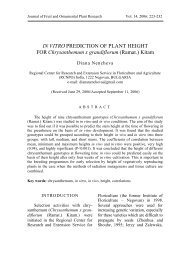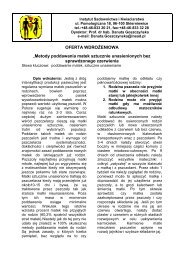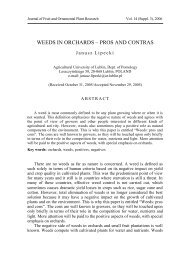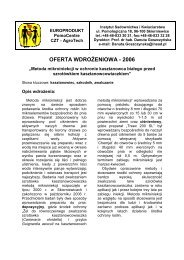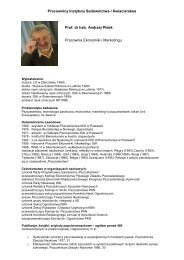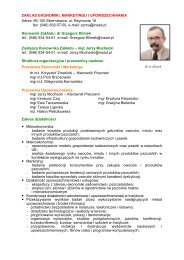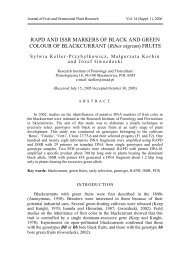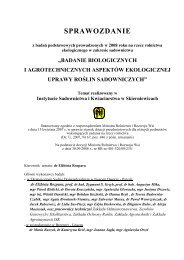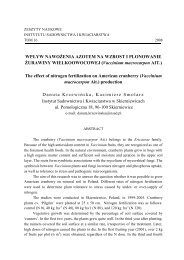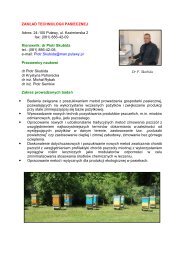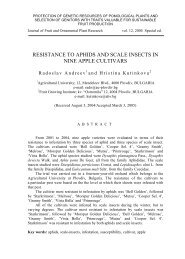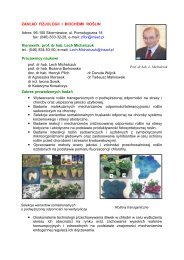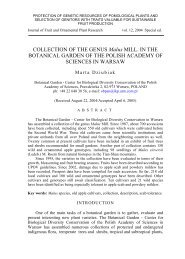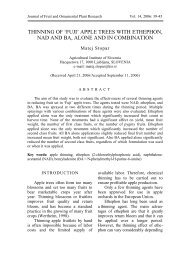Phytonemus pallidus ssp. fragariae Zimm. - Instytut Sadownictwa i ...
Phytonemus pallidus ssp. fragariae Zimm. - Instytut Sadownictwa i ...
Phytonemus pallidus ssp. fragariae Zimm. - Instytut Sadownictwa i ...
You also want an ePaper? Increase the reach of your titles
YUMPU automatically turns print PDFs into web optimized ePapers that Google loves.
Journal of Fruit and Ornamental Plant Research Vol. 14, 2006: 189-197<br />
SUSCEPTIBILITY OF STRAWBERRY CULTIVARS TO<br />
INFESTATION BY THE STRAWBERRY MITE<br />
(<strong>Phytonemus</strong> <strong>pallidus</strong> <strong>ssp</strong>. <strong>fragariae</strong> <strong>Zimm</strong>.)<br />
Barbara H. Łabanowska<br />
Research Institute of Pomology and Floriculture<br />
Pomologiczna 18, 96-100 Skierniewice, POLAND<br />
(Received March 27, 2006/Accepted May 31, 2006)<br />
A B S T R A C T<br />
Twenty strawberry cultivars were evaluated in terms of their susceptibility to<br />
infestation by the strawberry mite (<strong>Phytonemus</strong> <strong>pallidus</strong> <strong>ssp</strong>. <strong>fragariae</strong> <strong>Zimm</strong>.). The<br />
trial was carried out from 2000 to 2002 at the Dąbrowice Experimental Orchard near<br />
Skierniewice in central Poland. Two to four times each season, both motile forms and<br />
eggs were counted on randomly sampled leaves of each cultivar. The highest numbers<br />
of mites were generally found in June and July. All of the strawberry cultivars<br />
evaluated were susceptible to infestation by the strawberry mite. The most susceptible<br />
cultivars were ‘Marmolada’, ‘Kent’, ‘Honeoye’, ‘Evita’, ‘Elsanta’, ‘Selva’, ‘Polka’,<br />
‘Kastor’ and ‘Elkat’. Moderately susceptible cultivars included ‘Vega’, ‘Karel’,<br />
‘Seal’, ‘Selection 1476’, ‘Temira’, ‘Tarda Vicoda’, ‘Malling Pandora’, ‘Selection<br />
1248’ and ‘Senga Sengana’. The cultivars least susceptible to infestation by the<br />
strawberry mite were ‘Selection 723’ and ‘Pegasus’.<br />
Key words: strawberry, strawberry mite, <strong>Phytonemus</strong> <strong>pallidus</strong>, cultivars susceptibility<br />
INTRODUCTION<br />
The strawberry mite (<strong>Phytonemus</strong><br />
<strong>pallidus</strong> <strong>ssp</strong>. <strong>fragariae</strong> <strong>Zimm</strong>.) was<br />
first detected in Poland over seventy<br />
years ago. It is a common strawberry<br />
pest in many countries all over the<br />
world (Alford, 1972; Łęska, 1964;<br />
Schaefers, 1963; Suski, 1958).<br />
The strawberry mite damages<br />
plant foliage and greatly reduces fruit<br />
quality. Strawberries from infested<br />
plants are small, sour and difficult to<br />
sell on the fruit market. The strawberry<br />
mite also reduces yield, sometimes<br />
dramatically. The drop in yield<br />
is usually proportional to the level of<br />
infestation (Alford, 1976; Stenseth<br />
and Nordby, 1976).<br />
Finding acaricides effective in<br />
controlling the strawberry mite is<br />
always a problem. Purchasing resistant
B.H. Łabanowska<br />
and tolerant strawberry cultivars is<br />
also extremely difficult. Some cultivars<br />
are partially resistant to the strawberry<br />
mite, but as of yet, no totally resistant<br />
cultivars have been found (Alford,<br />
1972; Łabanowska, 2004; Berglund,<br />
2005).<br />
The aim of this study was to<br />
evaluate twenty strawberry cultivars<br />
in terms of their susceptibility to<br />
infestation by the strawberry mite.<br />
‘Senga Sengana’, the cultivar most<br />
widely grown in Poland, served as<br />
the reference cultivar.<br />
MATERIAL AND METHODS<br />
The experiment was carried out<br />
from 2000 to 2002 at the Dąbrowice<br />
Experimental Orchard, which belongs<br />
to the Research Institute of Pomology<br />
and Floriculture in Skierniewice in<br />
central Poland.<br />
In the spring of 1999, strawberry<br />
plants of twenty different cultivars<br />
were planted 0.5 x 1.0 meters apart in<br />
a field in which strawberries are grown<br />
every year. The cultivars evaluated are<br />
listed in Table 1. ‘Senga Sengana’ was<br />
included as the reference cultivar.<br />
The experiment was carried out<br />
in a randomized block design with<br />
four replications of fifty plants per<br />
plot. Each plot consisted of two<br />
rows, each of which was twelve<br />
meters long.<br />
No chemical pest and diseases<br />
control measures were carried out.<br />
Two to four times during the<br />
course of the growing season, ten<br />
leaves were randomly sampled from<br />
each plot. Strawberry mite motile<br />
forms and eggs were counted with the<br />
help of a stereoscopic microscope.<br />
Before statistical analysis, all<br />
data were transformed using the<br />
logarithmic function y = log (x+1),<br />
where x represents the number of<br />
mites found on the leaves sampled.<br />
All data were elaborated using<br />
analysis of variance, followed by<br />
means separation using Duncan’s<br />
multiple range t-test at P≤0.05.<br />
The cumulative index of infestation<br />
was then calculated for each<br />
cultivar (Wratten et al., 1979).<br />
RESULTS AND DISCUSSION<br />
The numbers of strawberry mites<br />
found on the leaves sampled are<br />
presented in Tables 1 and 2. The<br />
cumulative indices of infestation are<br />
presented in Table 3.<br />
The first observations were carried<br />
out in May, 2000. Strawberry mites<br />
were found on all twenty cultivars. The<br />
level of infestation varied from cultivar<br />
to cultivar. The differences between<br />
cultivars were sometimes statistically<br />
significant (Tab. 1).<br />
The highest numbers of mites<br />
were found on ‘Marmolada’ and<br />
‘Honeoye’, which had between 5.5<br />
and 6.5 mites per leaf. The numbers<br />
of eggs found on these cultivars was<br />
relatively high compared to the<br />
numbers of motile forms, and ranged<br />
from 6.3 to 8.3 eggs per leaf.<br />
The lowest numbers of mites<br />
were found on ‘Pegasus’, ‘Karel’,<br />
‘Seal’ and ‘Selection 723’, which<br />
had fewer than one motile form and<br />
two eggs per leaf.<br />
In the remaining cultivars,<br />
including ‘Senga Sengana’, the number<br />
of mites in May, 2000, ranged from 0.3<br />
to 4.3 per leaf.<br />
190<br />
J. Fruit Ornam. Plant Res. vol. 14, 2006: 189-197
Susceptibility of strawberry… by the <strong>Phytonemus</strong> <strong>pallidus</strong> <strong>ssp</strong>. <strong>fragariae</strong><br />
T a b l e 1 . Infestation of strawberry cultivars by motile forms of the strawberry mite<br />
(<strong>Phytonemus</strong> <strong>pallidus</strong> <strong>ssp</strong>. <strong>fragariae</strong> <strong>Zimm</strong>.); Dąbrowice Experimental Orchard, 2000<br />
Cultivar<br />
Mean number of motile forms per leaf<br />
May 23 July 10 August 9 August 29<br />
Elkat 0.3 b* 0.2 ab 1.9 b-d 5.3 c-f<br />
Elsanta 2.0 fg 4.1 f-j 3.7 cd 3.4 cd<br />
Evita 1.9 fg 1.0 c-e 1.7 b-d 8.3 e-g<br />
Honeoye 6.5 h 10.4 j 0.7 b 4.8 c-f<br />
Karel 0.1 a 1.6 d-f 4.1 cd 1.4 b<br />
Kastor 3.3 gh 2.8 fg 6.6 d 7.9 e-g<br />
Kent 4.3 gh 7.8 h-j 2.3 b-d 7.1 d-g<br />
Malling Pandora 1.8 fg 2.4 ef 1.8 b-d 2.9 c<br />
Marmolada 5.5 h 9.4 ij 6.1 d 3.9 c-e<br />
Pegasus 0.02 a 0.4 a-c 0.7 b 0.6 a<br />
Polka 3.2 gh 6.6 g-j 7.4 d 6.1 c-f<br />
Seal 0.1 a 1.0 c-e 0.6 b 6.2 c-f<br />
Selection 723 0.1 a 0.4 bc 0.7 b 0.8 ab<br />
Selection 1248 0.9 c-f 0.7 b-d 4.8 d 9.7 fg<br />
Selection 1476 0.5 b-e 0.5 bc 1.0 bc 4.9 c-f<br />
Selva 1.1 d-f 3.1 f-h 6.7 d 13.8 g<br />
Tarda Vicoda 0.4 bc 0.1 a 0.1 a 6.0 c-f<br />
Temira 1.3 ef 3.9 f-i 5.1 d 3.4 cd<br />
Vega 0.5 b-d 0.3 a-c 2.9 b-d 4.8 c-f<br />
Senga Sengana ** 2.1 fg 1.9 d-f 1.1 bc 6.4 d-f<br />
*Means in the same column followed by the same letter are not significantly different according to<br />
Duncan’s multiple range t-test at P≤0.05.<br />
**Reference cultivar<br />
J. Fruit Ornam. Plant Res. vol. 14, 2006: 189-197 191
B.H. Łabanowska<br />
T a b l e 2 . Infestation of strawberry cultivars by motile forms of the strawberry<br />
mite (<strong>Phytonemus</strong> <strong>pallidus</strong> <strong>ssp</strong>. <strong>fragariae</strong> <strong>Zimm</strong>.); Dąbrowice Experimental Orchard,<br />
2001 and 2002<br />
Mean number of motile forms per leaf<br />
Cultivar<br />
2001 2002<br />
June 26 August 6 August 23 June 5 June 25<br />
Elkat 3.0 e-g* 5.1 gh 0.5 b 7.7 hi 8.1 h<br />
Elsanta 5.4 g-i 7.9 h-j 1.1 c 6.4 g-i 8.8 h<br />
Evita 1.7 de 3.4 g 5.4 e no plants<br />
Honeoye 8.7 i 4.9 gh 11.2 f 5.6 f-h 3.4 fg<br />
Karel 2.0 d-f 0.7 b-d 3.2 d 1.7 cd 1.4 cd<br />
Kastor 1.5 cd 6.8 h-j 3.5 d 10.7 i 3.8 fg<br />
Kent 0.9 bc 5.1 gh 0.7 b 3.6 e-g 7.4 h<br />
Malling Pandora 0.6 b 0.4 b 1.1 c 3.8 e-g 4.3 g<br />
Marmolada 4.8 g-i 10.3 ij 0.7 b 10.7 i 7.6 h<br />
Pegasus 3.4 f-h 0.9 c-e 0.7 b 1.6 cd 1.5 cd<br />
Polka 5.4 g-i 1.3 d-f 1.6 c 2.3 de 1.0 bc<br />
Seal 2.1 d-f 0.7 bc 0.2 a 3.5 e-g 3.0 e-g<br />
Selection 723 0.6 b 0.5 b 4.0 de 0.1 a 0.6 b<br />
Selection 1248 5.2 g-i 1.4 ef 0.7 b 0.4 b 3.3 fg<br />
Selection 1476 0.8 b 1.8 f 1.4 c 3.2 ef 4.3 g<br />
Selva 6.2 hi 11.7 j 3.1 d 4.4 f-h 1.8 c-e<br />
Tarda Vicoda 5.4 g-i 6.1 g-i 0.2 a 0.2 ab 0.3 a<br />
Temira 2.5 d-f 0.2 a 3.2 d 2.1 de 1.1 c<br />
Vega 0.2 a 4.8 gh 0.5 b 1.0 c 0.3 a<br />
Senga Sengana ** 0.8 bc 0.4 b 3.2 d 2.3 de 2.4 d-f<br />
*For explanations, see Table 1<br />
**Reference cultivar<br />
192<br />
J. Fruit Ornam. Plant Res. vol. 14, 2006: 189-197
Susceptibility of strawberry… by the <strong>Phytonemus</strong> <strong>pallidus</strong> <strong>ssp</strong>. <strong>fragariae</strong><br />
T a b l e 3 . Infestation of strawberry cultivars by the strawberry mite (<strong>Phytonemus</strong><br />
<strong>pallidus</strong> <strong>ssp</strong>. <strong>fragariae</strong> <strong>Zimm</strong>.) as expressed in terms of the cumulative index of<br />
infestation calculated on the basis of the numbers of strawberry mite motile forms and<br />
eggs; Dąbrowice Experimental Orchard, 2000 to 2002<br />
Cultivar<br />
motile<br />
forms<br />
2000 2001 2002<br />
eggs<br />
motile<br />
forms<br />
eggs<br />
motile<br />
forms<br />
eggs<br />
Elkat 117.4 ab* 118.2 ab 223.4 ef 355.4 f-h 158.8 i 267.5 i<br />
Elsanta 312.0 c-f 579.3 e-g 351.2 hi 402.3 gh 152.8 i 208.8 h<br />
Evita 219.1 b-d 352.4 b-e 184.5 e 281.7 d-f no plants<br />
Honeoye 584.9 hi 733.0 g 425.0 j 629.6 i 94.0 gh 120.5 e-g<br />
Karel 176.7 a-d 207.7 a-c 95.5 a-c 133.8 a-c 32.0 a-d 64.3 b-d<br />
Kastor 396.6 e-g 475.2 d-f 269.1 fg 324.5 e-g 148.8 i 157.3 g<br />
Kent 507.8 gh 788.0 g 173.8 de 251.2 de 115.3 h 156.8 g<br />
Malling<br />
Pandora<br />
224.4 b-d 351.4 b-e 34.9 a 48.1 a 83.3 fg 103.0 de<br />
Marmolada 670.2 i 809.7 g 412.8 ij 441.4 h 185.8 j 236.3 hi<br />
Pegasus 49.3 a 36.6 a 112.0 b-d 126.3 a-c 32.8 b-d 47.3 ab<br />
Polka 534.0 g-i 749.8 g 172.1 de 186.4 b-d 33.5 b-d 32.5 ab<br />
Seal 123.8 ab 106.9 ab 66.8 ab 113.7 a-c 66.0 ef 94.3 c-e<br />
Selection 723 50.9 a 45.3 a 65.8 ab 94.1 ab 8.3 ab 9.3 a<br />
Selection 1248 250.0 b-e 263.9 a-d 158.9 c-e 209.7 cd 38.0 cd 56.3 bc<br />
Selection 1476 124.3 ab 112.4 ab 84.1 ab 190.3 b-d 80.5 fg 108.8 ef<br />
Selva 422.7 fg 680.9 fg 501.1 k 592.7 i 64.8 ef 146.5 fg<br />
Tarda Vicoda 94.7 ab 112.7 ab 293.0 gh 379.2 gh 6.5 a 12.5 a<br />
Temira 319.7 d-f 445.6 c-f 86.3 ab 105.0 ab 35.5 cd 33.5 ab<br />
Vega 147.8 a-c 146.6 ab 157.6 c-e 214.4 cd 13.5 a-c 9.8 a<br />
Senga<br />
Sengana**<br />
217.6 b-d 401.7 c-e 57.7 ab 70.0 a 49.8 de 48.8 ab<br />
*For explanations, see Table 1<br />
**Reference cultivar<br />
J. Fruit Ornam. Plant Res. vol. 14, 2006: 189-197 193
B.H. Łabanowska<br />
The number of mites increased<br />
during July and August. At the end of<br />
August, the highest number of mites<br />
was found on ‘Selva’, which had 13.8<br />
mites per leaf. High numbers of mites<br />
were also found on ‘Kent’,<br />
‘Marmolada’, ‘Kastor’, ‘Evita’ and<br />
‘Selection 1248’, which had between<br />
6.6 and 9.7 mites per leaf. The<br />
differences between these cultivars and<br />
‘Selva’ were not statistically significant.<br />
In ‘Pegasus’ and ‘Selection 723’,<br />
however, the number of mites<br />
remained low until the end of August,<br />
and never exceeded 0.8 mites per leaf.<br />
The overall level of infestation for<br />
the 2000 growing season was highest<br />
in ‘Marmolada’, ‘Selva’, ‘Polka’,<br />
‘Honeoye’, ‘Kent’, ‘Kastor’, ‘Evita”<br />
and ‘Selection 1248’, on which at the<br />
date, when the highest number of mites<br />
was noted between 7.4 and 13.8 mites<br />
per leaf. In these cultivars, mites were<br />
found on 65% to 95% of the leaves<br />
sampled.<br />
‘Elsanta’, ‘Temira’ ‘Vega’,<br />
‘Malling Pandora’, ‘Tarda Vicoda’,<br />
‘Karel’, ‘Elkat’, ‘Seal’ and ‘Selection<br />
1476’ were moderately infested, as<br />
was ‘Senga Sengana’. At the end of<br />
the growing season, the number of<br />
mites on ‘Senga Sengana’ was 6.4<br />
per leaf, and mites were found on<br />
35% of the leaves sampled.<br />
The overall level of infestation for<br />
the 2000 growing season was lowest in<br />
‘Pegasus’ and ‘Selection 723’, which<br />
had fewer than one mite per leaf. In<br />
these cultivars, mites were found on<br />
only a few percents of the leaves<br />
sampled.<br />
The number of eggs was<br />
generally correlated with the number<br />
of motile forms found.<br />
In all of the highly and moderately<br />
infested cultivars, the number of mites<br />
found per leaf was higher than four,<br />
which is the economic threshold level.<br />
Infestation below this level has no<br />
significant effect on yield the next year<br />
(Alford, 1972;1976). Infestation above<br />
the threshold level, however, does<br />
reduce yield the next year<br />
(Berglund, 2005).<br />
Predatory mites of the family<br />
Phytoseiidae were also counted.<br />
However, because they were present<br />
only in low numbers, it was difficult<br />
to draw any conclusions on the<br />
relationship between the strawberry<br />
mite and phytoseiid mites for the<br />
cultivars evaluated.<br />
At the end of June, 2001, the<br />
strawberry mite was found on all<br />
twenty cultivars. The differences in<br />
infestation level between cultivars<br />
was statistically significant (Tab. 2).<br />
The highest numbers of mites were<br />
found on ‘Marmolada’, ‘Polka’, ‘Tarda<br />
Vicoda’, ‘Elsanta’, ‘Selva’, ‘Honeoye’<br />
and ‘Selection 1248’, which had<br />
between 4.8 and 8.7 motile forms per<br />
leaf, and between 5.0 and 12.6 eggs<br />
per leaf.<br />
The lowest numbers of mites were<br />
found on ‘Vega’, ‘Malling Pandora’,<br />
‘Senga Sengana’, ‘Kent’, ‘Selection<br />
723’ and ‘Selection 1476’, which had<br />
fewer than one motile form per leaf,<br />
and fewer than 1.2 eggs per leaf.<br />
The remaining cultivars had<br />
between 1.0 and 3.4 motile forms per<br />
leaf.<br />
In most cultivars, the number of<br />
mites was high at the beginning of<br />
August, but by the end of the month<br />
had dropped significantly to 0.2 to<br />
11.2 mites per leaf.<br />
194<br />
J. Fruit Ornam. Plant Res. vol. 14, 2006: 189-197
Susceptibility of strawberry… by the <strong>Phytonemus</strong> <strong>pallidus</strong> <strong>ssp</strong>. <strong>fragariae</strong><br />
The overall level of infestation for<br />
the 2001 growing season was highest<br />
in ‘Honeoye’, ‘Selva’ and ‘Marmolada’,<br />
which had between 8.7 and 11.2;<br />
6.2 and 11.7 or 4.8 and 10. 3 mites per<br />
leaf, respectively. In these cultivars,<br />
the cumulative index of infestation was<br />
seven to eight times higher than in<br />
‘Senga Sengana’.<br />
‘Vega’, ‘Kent’, ‘Polka’, ‘Elkat’,<br />
‘Evita’, ‘Kastor’, ‘Tarda Vicoda’,<br />
‘Elsanta’ and ‘Selection 1248’ were<br />
moderately infested, and had between<br />
4.8 and 8.0 mites per leaf.<br />
In all of the highly and moderately<br />
infested cultivars, the number of mites<br />
was higher than the economic<br />
threshold level.<br />
The overall level of infestation for<br />
the 2001 growing season was lowest in<br />
‘Malling Pandora’, ‘Seal’, ‘Pegasus’,<br />
‘Temira’, ‘Karel’, ‘Selection 1476’<br />
‘Selection 723’ and ‘Senga Sengana’,<br />
which all had fewer than four mites per<br />
leaf.<br />
The number of eggs was again<br />
correlated with the number of motile<br />
forms found.<br />
Phytoseiid mites were found only<br />
in low numbers on the leaves sampled.<br />
In 2002, mites were found on all of<br />
the cultivars except ‘Evita’, which had<br />
dried out (Tab 2).<br />
The overall level of infestation for<br />
the 2002 growing season was highest<br />
in ‘Elkat’, ‘Elsanta’, ‘Honeoye’,<br />
‘Kastor’, ‘Kent’ and ‘Marmolada’,<br />
which had between 3.4 and 10.7 mites<br />
per leaf. ‘Selva’, ‘Seal’, ‘Selection<br />
1476’, ‘Malling Pandora’ and ‘Senga<br />
Sengana’ were moderately infested,<br />
and had between 2.3 and 4.4 mites per<br />
leaf. The overall level of infestation for<br />
the 2002 growing season was lowest in<br />
‘Tarda Vicoda’, ‘Selection 723’,<br />
‘Vega’, ‘Pegasus’, ‘Karel’, ‘Polka’,<br />
‘Temira’ and ‘Selection 1248’.<br />
Throughout the three year<br />
observation period, the strawberry mite<br />
was found on all of the cultivars<br />
evaluated. The strawberry mite had<br />
been previously found on various<br />
strawberry cultivars (Łabanowska,<br />
2004; Berglund, 2005).<br />
The numbers of mites found varied<br />
from year to year, and from month to<br />
month in a particular year.<br />
The cultivars with the highest<br />
three-year overall level of infestation<br />
were ‘Marmolada’, ‘Kent’, ‘Honeoye’,<br />
‘Evita’, ‘Kastor’, ‘Selva’, ‘Polka’,<br />
‘Elsanta’ and ‘Elkat’. Cultivars which<br />
were moderately infested included<br />
‘Vega’, ‘Karel’, ‘Seal’, ‘Selection<br />
1248’, ‘Selection 1476’, ‘Temira’,<br />
‘Tarda Vicoda’, ‘Malling Pandora’ and<br />
‘Senga Sengana’. The cultivars with<br />
the lowest three-year overall level of<br />
infestation were ‘Selection 723’ and<br />
‘Pegasus’.<br />
In an earlier experiment in which<br />
‘Senga Sengana’ also served as the<br />
reference cultivar, it was less infested<br />
by the strawberry mite than all of the<br />
other cultivars evaluated (Łabanowska,<br />
2004). Also, in previous experiments,<br />
‘Kent’, ‘Elsanta’ and ‘Honeoye’ were<br />
only moderately infested (Łabanowska,<br />
2004).<br />
CONCLUSIONS<br />
1. All of the strawberry cultivars<br />
evaluated were susceptible to<br />
infestation by the strawberry mite<br />
(<strong>Phytonemus</strong> <strong>pallidus</strong> <strong>ssp</strong>.<br />
<strong>fragariae</strong> <strong>Zimm</strong>.).<br />
2. Of the cultivars evaluated, those<br />
most susceptible to infestation by<br />
the strawberry mite were ‘Marmolada’,<br />
‘Kent’, ‘Honeoye’, ‘Evita’,<br />
J. Fruit Ornam. Plant Res. vol. 14, 2006: 189-197 195
B.H. Łabanowska<br />
‘Elsanta’, ‘Selva’, ‘Polka’,<br />
‘Kastor’ and ‘Elkat’.<br />
3. ‘Vega’, ‘Karel’, ‘Seal’, ‘Selection<br />
1476’, ‘Temira’, ‘Tarda Vicoda’,<br />
‘Malling Pandora’, ‘Selection<br />
1248’ and ‘Senga Sengana’ were<br />
moderately susceptible.<br />
4. The cultivars which were least<br />
susceptible to infestation by the<br />
strawberry mite were ‘Selection<br />
723’ and ‘Pegasus’.<br />
Acknowledgements: I would<br />
like to thank Bożena Zaradna for<br />
technical help in conducting the<br />
experiments.<br />
REFFERENCES<br />
Alford D.V. 1972. The effect of<br />
Tarsonemus <strong>fragariae</strong> <strong>Zimm</strong>ermann<br />
(Acarina: Tarsonemidae) on strawberry<br />
yields. ANN. APP. BIOL. 70: 13-18.<br />
Alford D.V. 1976. Some observations on<br />
the effect of pests on strawberry yields.<br />
ANN. APP. BIOL. 84: 440-444.<br />
Berglund R. 2005. The use of Amblyseius<br />
cucumeris to control <strong>Phytonemus</strong><br />
<strong>pallidus</strong> under field conditions.<br />
Integrated Plant Protection in Fruit<br />
Crops – Soft Fruit. IOBC, Workshop<br />
on integrated soft fruit production.<br />
Norway, Abstract, p. 29.<br />
Łabanowska B.H. 2004. Spread of the<br />
strawberry mite (<strong>Phytonemus</strong> <strong>pallidus</strong><br />
<strong>ssp</strong>. <strong>fragariae</strong> <strong>Zimm</strong>.) on thirteen<br />
strawberry cultivars. J. FRUIT<br />
ORNAM. PLANTS. 12: 105-111.<br />
Łęska W. 1964. Roztocz truskawkowy –<br />
Steneotarsonemus <strong>pallidus</strong> Banks<br />
(Acarina, Tarsonemidae) i metody<br />
ograniczające jego występowanie.<br />
POL. PISM. ENT. Ser. B: 1-2(33-34):<br />
113-121.<br />
Schaefers G.A. 1963. Seasonal densities<br />
and control of the cyclamen mite<br />
Steneotarsonemus <strong>pallidus</strong> (Acarina:<br />
Tarsonemidae), on strawberry in New<br />
York. J. ECON. ENT. 56: 65-71.<br />
Stenseth C.H., Nordby A. 1976. Damage<br />
and control of the strawberry mite<br />
Steneotarsonemus <strong>pallidus</strong> (Acarina:<br />
Tarsonemidae), on strawberries.<br />
J. HOR. SC. 51: 49-54.<br />
Suski Z.W. 1958. Wyniki jednorocznych<br />
badańnad wystąpieniem w Polsce<br />
roztocza truskawkowego (Tarsonemus<br />
<strong>pallidus</strong> Banks. Acarina: Tarsonemidae).<br />
PR. INST. SAD. 3: 171-<br />
176.<br />
Wratten S.D., Lee G., Stevens D.J. 1979.<br />
Duration of cereal aphid populations<br />
and the effects on wheat yield and<br />
quality. Proc. Brighton Crop Prot.<br />
Conf. I, pp. 1-8.<br />
196<br />
J. Fruit Ornam. Plant Res. vol. 14, 2006: 189-197
Susceptibility of strawberry… by the <strong>Phytonemus</strong> <strong>pallidus</strong> <strong>ssp</strong>. <strong>fragariae</strong><br />
ZASIEDLENIE DWUDZIESTU ODMIAN TRUSKAWKI<br />
PRZEZ ROZTOCZA TRUSKAWKOWCA – <strong>Phytonemus</strong><br />
<strong>pallidus</strong> <strong>ssp</strong>. <strong>fragariae</strong> <strong>Zimm</strong>.<br />
Barbara H. Łabanowska<br />
S T R E S Z C Z E N I E<br />
Doświadczenia nad występowaniem roztocza truskawkowca na 20 odmianach<br />
truskawek prowadzono w latach 2000-2002 w Sadzie Doświadczalnym <strong>Instytut</strong>u<br />
<strong>Sadownictwa</strong> i Kwiaciarstwa w Dąbrowicach k. Skierniewic. Liczebnośćstadiów<br />
ruchomych i jaj roztocza określano 2-4 razy w sezonie wegetacji. W grupie<br />
obserwowanych odmian żadna nie okazała sięcałkowicie odporna na roztocza.<br />
Najsłabiej zasiedlane przez roztocza były odmiany – ‘Klon 723’ i ‘Pegasus’,<br />
średnio – ‘Vega’, ‘Karel’, ‘Senga Sengana’, ‘Seal’, ‘Klon 1248’, ‘Klon 1476’,<br />
‘Temira’, ‘Tarda Vicoda’ i ‘Malling Pandora’, a najsilniej – ‘Marmolada’, ‘Kent’,<br />
‘Honeoye’, ‘Evita’, ‘Kastor’, ‘Selva’, ‘Polka’, ‘Elsanta’ i ‘Elkat’.<br />
Słowa kluczowe: truskawka, roztocz truskawkowiec Phytonomus <strong>pallidus</strong> <strong>ssp</strong>.<br />
<strong>fragariae</strong>, podatnośćodmian<br />
J. Fruit Ornam. Plant Res. vol. 14, 2006: 189-197 197



